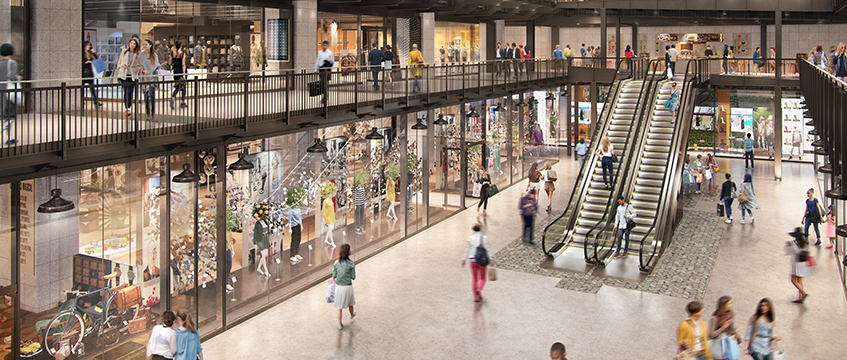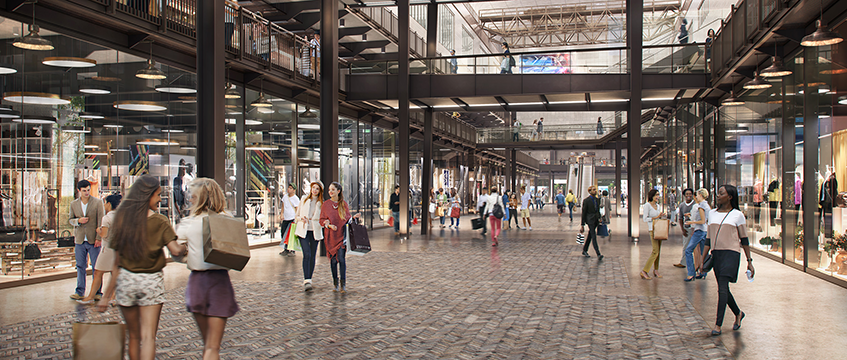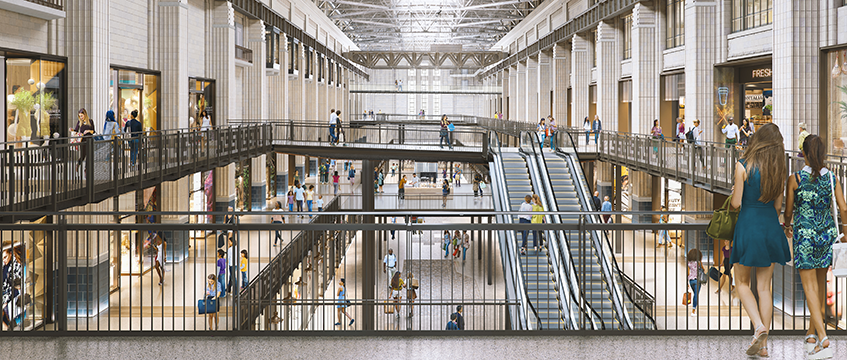Battersea Power Station Development Company has unveiled its vision for the retail and leisure element of its £8bn regeneration project, which it hopes will become the “fourth retail pillar of London.”
It has now begun marketing the 700,000 sq ft of retail and 225,000 sq ft of leisure space across more than 100 shops and 40 restaurants at the project.
While this may seem like a lot of space to be added to what is currently being described as an oversupplied market, the developers are confident their vision for the project is so unique that the struggle will not be finding enough tenants, but the right ones.
“The challenge is going to be picking the right mix, because there are going to be so many people who want to come in,” says Rob Tincknell, chief executive, Battersea Power Station Development Company.
The project is due to open in 2020 and BPSDC is planning on opening all the retail and leisure inside the main power station at the same time. This means it needs to start getting offers in the door and over the line.
What will it be like?
Although there will be more than 100 shops under one roof, BPSDC is keen to stress it will not be a regular shiny shopping centre.
“In many shopping centres you could be anywhere – take the blindfold off and you could be in Kuala Lumpar or Hong Kong – but when you come here and walk through these spaces you will have no doubt as to where you are and that’s a massive point,” says deputy chief executive and chief financial officer Simon Murphy.
“It is going to be about great shopping and a great experience, in an emotional way as well as in a financial way,” he says.
Unlike most shopping centres, there will be no anchor store. The retail and leisure space will be in the two former turbine halls, which were the power station’s original control rooms. This will be split over three floors, with retail sitting under the restaurant and office space, which will host Apple’s new 500,000 sq ft HQ.

Turbine Hall A, which was built in the 1930s and will include some of the original art deco facades, will be home to the Premium Collection, which will include luxury brands. Turbine Hall B, completed in the 1950s, will have more of an industrial feel and will target younger, urban brands.
“We are not doing the traditional form of anchoring in the power station,” says leasing director Sam Cotton. “Instead, we are taking this in a category approach and that’s very much our invitation and pitch to brands.
“We see this as a collection of leaders of respected categories. We are certainly not aware of that approach taking place anywhere else and we feel this is a unique way of doing it.
There will be no two units exactly the same, and they will range from 2,000 sq ft for smaller brands and start-ups to 10,000 sq ft flagships.
There will be four main restaurants as well as a 35,000 sq ft food hall. Helen Carr, director of F&B leasing, is similarly looking to attract a range of tenants that you could not find elsewhere in London.
It will not be targeting chains and brands against the backdrop of recent casual dining insolvencies.
“We are looking for new concepts, emerging talents and renowned chefs from around the world, which is really exciting,” she says.
How to make a historic building survive in the future
This leasing strategy is intrinsic to the developer’s approach to the biggest challenge in all retail developments – how to futureproof your project.
Cotton says retailers have been expressing interest in the site since 2014, but there have been no prelets in order to ensure the final tenant mix reflects the current retail demand upon opening.
“This is why we haven’t started yet as you don’t want to go too early – they could be fantastic today, but not a great brand tomorrow,” says Tincknell.
Cotton adds: “It is easy to look back at what has happened and what has been a success and what has failed in different concepts of retailing, but it is much harder to look forward and to understand what is happening – that is a huge part of the strategy.”
The Battersea experience
The combination of this retail line-up against the backdrop of the power station will, the developer hopes, make a destination people will want to visit in its own right. This will include locals from the surrounding area as well as from elsewhere in London who will be able to travel south of the river on the extension of the Northern line.
This is what Tincknell believes will make the development stand the test of time and be a success. He has a grand vision for how the power station will resonate with people.
“People measure their success these days by less material things,” he says.
“It is not about the watch you are wearing or the handbag you have, it is about the pictures you have on Instagram about diving with sharks or standing at the top of Kathmandu. It is about experiences.
“The first Friday of every month I want to turn the turbine halls into a massive club, a massive party, it could be incredible – turn up, buy some shoes, end up in the best party you’ve been to for months. You would Instagram it and say ‘Look what I did last night – I went to Battersea Power Station.”’
Will it work? A local’s view, by Amber Rolt
Do we really need more retail space in London? Given the current scarcity of offerings south of the river, then a new retail destination in SW11 could be a big hit.
As a Battersea resident, unless your hobbies include dodgy manicures, browsing charity shops, gambling or redecorating your kitchen, then there is not much on offer. F&B-wise, unless you’re keen to survive on takeaways or pub food, the offerings are similarly slim.
Those looking for a retail experience can head over the bridge to the King’s Road, SW3. There’s a Peter Jones there, which is nice, but since the domination of the chains and rising property prices pushed out some of the road’s famous shops such as King’s Road Sporting Club and R Soles, much of the street has lost its charm of the 1970s and 1980s. However, if you love athleisure wear and overpriced cappuccinos, you’ll be spoilt for choice.
The alternative is Southside shopping centre in Wandsworth, SW18. At 630,000 sq ft and after a strong asset management initiative undertaken by Delancey last year, there is plenty on offer. But it’s not quite in the neighbourhood and only accessible if you’re willing to take the long bus journey.
When the new Tube line is open in 2020, those from Clapham and surrounding areas will be able to get to the power station easily.
Its initial restaurant and bar openings in Circus West Village have demonstrated that people are willing to make the trip from not just the local area but from over the bridge too.
Restaurant and bar No.29 Power Station West opened last summer alongside a handful of restaurants, including pizza eatery Mother, and despite being tucked away under the cranes in a half-built development, these spots are already drawing strong crowds at weekends.
There has been talk for some time now in the area that once the power station is finished the whole neighbourhood will improve. Yes, 700,000 sq ft is a lot of space, but if Tincknell and his team succeed in their vision and deliver on time, then the crowds should come flooding in.

To send feedback, e-mail amber.rolt@egi.co.uk or tweet @AmberRoltEG or @estatesgazette











